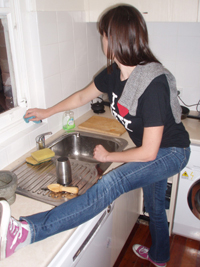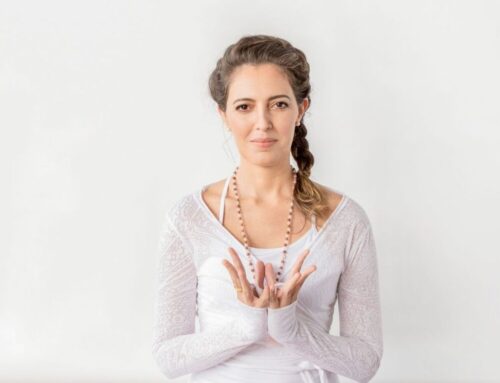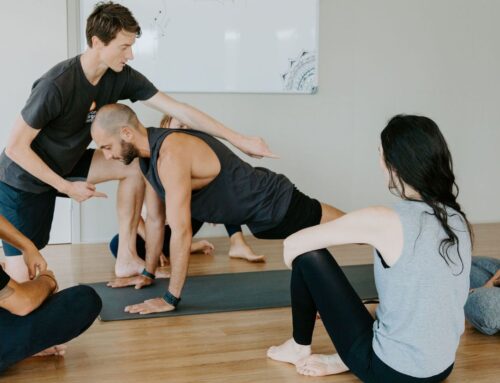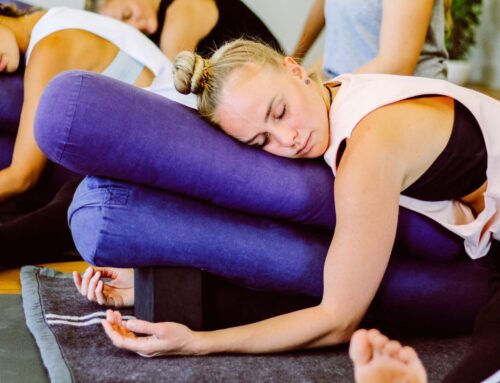Written by Brook McCarthy
Yoga teachers enthuse that, ‘yoga is nothing without a home practice’. Home practice gives self-insight into how you respond to difficulty and ease, heightens self-awareness of the body, and cultivates your ability to care for yourself. But starting – or resuming – your home practice can be intimidating, hard to manage, or just plain dull. Discover these tips for starting and maintaining your home practice.
"People with a home practice are less likely to be acting under the influence of ‘ego' and more likely to listening compassionately to their body's inner wisdom and what it needs at any given time," says Ana Davis, yoga teacher trainer who teaches the women's health components of the Byron Yoga Centre level 1 and 2 courses.
1. Carve out a space for your practice
With a basket of washing, a computer and a bench full of dishes in need of cleaning watching, laying out the mat amidst the chaos is not an easy task. The warm up goes well and then, spying the dishes upside down in down face dog, you are moving towards them before you've even realised what you're doing.
Finding a physical space and specific time for your practise can help immeasurably in your home practise. You don't need a whole room, a corner will do. If you're practising near a TV or computer, throwing a cloth over them symbolically communicates that these are not a distraction.
2. Have a sequence
Choose a well-rounded sequence to be your foundation. If you've particularly enjoyed a yoga class, ask the teacher to write down the sequence of all or part of it. Chances are they will be flattered and delighted by your enthusiasm. Even better, treat yourself to a private session with your teacher who can work with you to design a home-practice just for you. A written sequence is invaluable not only for newer students who aren't familiar with the rationale of sequencing, but also for more experienced students, who can gain inspiration on dull days or give focus to frenetic practice.
As a general rule, your sequence should include one or two poses from all categories in this order: warm up and standing poses, then arm balances, inversions, backbends, twists, forward bends, restorative poses, and not forgetting to end with corpse pose (Savasana).
3. Prioritise your yoga
‘Where does the time go?' is a common lament, but what you make time for comes down to your priorities. "When you start to practice yoga regularly at home, it becomes your yoga; you start to ‘own' your practice," says Ana. "You are able to tap into the changing rhythms of your body and emotions and adjust your practice accordingly."
When you experience some tangible benefits from your home practice, you can recall this when your enthusiasm is waning and make it a priority to seek these benefits over and over again.
4. Ask yourself what you need
Make your practice an expression of your present state of mind and body. This will ensure that you will be present in your practice. "If you are feeling particularly tired or stressed, you can practise more gently and restoratively, and work with, not against your energy," says Ana. "If you were to attend a class in this fragile state, you may find that you get caught up in the ‘energy' of the class, and may be tempted to over-do it and end up burning out."
"For women, having our own home practice is a double-boon. We can choose to do a special practice during menstruation, or a ‘cooling' practice to soothe the agitation of menopausal hot-flushes."
5. Use a microscope
Your home practice is your laboratory and the subject is yourself. This is the place to examine the effects of a pose on your body-mind. You can do this by holding the pose longer than you normally would, observing your body-mind's reactions within the pose and lying down after each pose.
"Students with a regular, committed home practice tend to show a heightened level of body awareness and sensitivity as they move through the postures," says Ana.
Each body is different – some poses in class come easily and naturally while others appear eternally illusive. If you only practise yoga in class then your easy poses will progress while the poses that you find difficult tend to stagnate, without showing much improvement.
Related articles





